She divorced me and moved to Canada, but we were once in love:
Wednesday, December 29, 2010
Monday, December 27, 2010
Tesla Gods at the Make Fair
Does anyone know why the bolts have a specific color, is it the amount of elements that are in the air at the time of ionization?
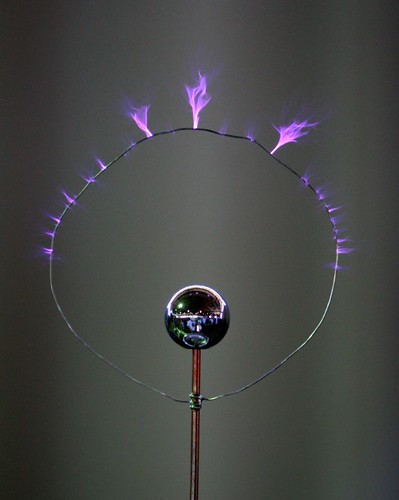
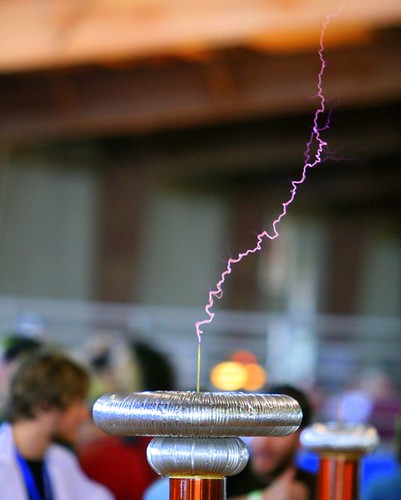


Labels:
Flicker
Saturday, December 25, 2010
Ampere - A to Z of Electronics
Jeri is amazing her videos are well done, you have to love paper cut outs....if you don't your not cool...ok your cool just keep that to your self. Hope to see some more of these videos.
I think I am going to start up a page on my blog dedicated to learning electronics from youtube. Any thoughts on this?
I think I am going to start up a page on my blog dedicated to learning electronics from youtube. Any thoughts on this?
Music Production for Film and Television with Malcolm Kirby Jr.
There is some really good information in this video definitely worth watching some bits and pieces.
Thursday, December 23, 2010
Ramirez Bass Guitars: Winding a stacked humbucking pickup
This guy is really cool he built his own winding machine for his hand built bass guitars
Sunday, December 19, 2010
555+4040 = Fun on a rainy day
Nothing much to do today school it finally over and I got some more time to mess around in the garage. Nothing to fancy here just a 555 acting as a clock for a 4040 and having a grand old time. The signal is pulsing because the power rail is coming in contact with one of the outputs of the 4040.
Labels:
4040,
555,
Noise,
Personal Build
Railroad Gin Episode 3
Railroad Gin Episode 3
Hello everyone! Thanks for checking out the written portion of the Railroad Gin video blog. I figured that I would do this as well as the video blog so i'm not blabbing forever on the video blog. Anyway. Episode Three is about Murder Ballads, specifically I talked about the song "Rose Connelly". It's a West Virginian Murder Ballad about a man who is coerced by his father to kill the woman he loves for her money. I got this song, its chords and partially its melody straight out of Alan Lomax's "Folk Songs of North America" which is obviously something you need to own if your interested in Folk Music.
Check out Matts blog here
Hello everyone! Thanks for checking out the written portion of the Railroad Gin video blog. I figured that I would do this as well as the video blog so i'm not blabbing forever on the video blog. Anyway. Episode Three is about Murder Ballads, specifically I talked about the song "Rose Connelly". It's a West Virginian Murder Ballad about a man who is coerced by his father to kill the woman he loves for her money. I got this song, its chords and partially its melody straight out of Alan Lomax's "Folk Songs of North America" which is obviously something you need to own if your interested in Folk Music.
Check out Matts blog here
Labels:
Rail Road Gin
MastersFromTheirDay.com #4 - Sherlock's Daughter - "Out In The Cold" - ...
These Masters From Their Day are amazing its great to be able to see inside of running studios. I know I am a total gear geek.
Labels:
General
Saturday, December 18, 2010
The Posible Future of Electronics Graphene
The Royal Swedish Academy of Sciences has awarded the Nobel Prize in Physics for 2010 to Andre Geim and Konstantin Novoselov, both of the University of Manchester, "for groundbreaking experiments regarding the two-dimensional material graphene."
Graphene is a form of carbon. As a material it is completely new -- not only the thinnest ever but also the strongest. As a conductor of electricity it performs as well as copper. As a conductor of heat it outperforms all other known materials. It is almost completely transparent, yet so dense that not even helium, the smallest gas atom, can pass through it. Carbon, the basis of all known life on earth, has surprised us once again.
When mixed into plastics, graphene can turn into conductors of electricity while making them more heat resistant and mechanically robust. Graphene transistors are predicted to be substantially faster than today's silicon transistors and result in more efficient computers
Some allotropes of carbon: a) diamond; b) graphite; c) lonsdaleite; d–f) fullerenes (C60, C540, C70); g) amorphous carbon; h) carbon nanotube.
Full Story at Science Daily
Graphene is a form of carbon. As a material it is completely new -- not only the thinnest ever but also the strongest. As a conductor of electricity it performs as well as copper. As a conductor of heat it outperforms all other known materials. It is almost completely transparent, yet so dense that not even helium, the smallest gas atom, can pass through it. Carbon, the basis of all known life on earth, has surprised us once again.
When mixed into plastics, graphene can turn into conductors of electricity while making them more heat resistant and mechanically robust. Graphene transistors are predicted to be substantially faster than today's silicon transistors and result in more efficient computers
Some allotropes of carbon: a) diamond; b) graphite; c) lonsdaleite; d–f) fullerenes (C60, C540, C70); g) amorphous carbon; h) carbon nanotube.
Friday, December 17, 2010
How a quartz watch works
This guy is great he is a college professor to my knowledge whats great is he beaks thing down so that you can relate them to everyday things. Also it goes to show you how much you take for granted in your every day life.
Thursday, December 16, 2010
How mobile handset SNR requirements impact audio performance
 The mobile phone market continues to evolve from primarily voice communications devices to sophisticated organizational and entertainment “appliances.” With the arrival of smartphones, users enjoy feature-rich portability, such as an integrated MP3 players, video playback, video and still picture cameras, blue-tooth, and GPS--all with a touch screen interface.
The mobile phone market continues to evolve from primarily voice communications devices to sophisticated organizational and entertainment “appliances.” With the arrival of smartphones, users enjoy feature-rich portability, such as an integrated MP3 players, video playback, video and still picture cameras, blue-tooth, and GPS--all with a touch screen interface.Additionally, operating systems with true multitasking have arrived with seemingly limitless applications, resulting in a powerful handheld tool. The smartphone is truly a unique example of engineering innovation that is changing people’s lives.
Along with this functionality, smartphone users expect high performance. This article addresses a key area of handset performance:, the mobile phone's audio playback, specifically the MP3-player audio output to headphones or earbuds.
Via EETimes
Via EETimes
Wednesday, December 15, 2010
Broke 1000 views
Just broke 1000 views for this month alone thanks to everyone for stoping by and checking out the blog!
Labels:
General
Tuesday, December 14, 2010
Darlington Learns about Electrophorus
Jeri and Darlington the cat play with electrophorus. The Last part about layden jar capacitors is really outstanding.
Labels:
DIY Jeri Ellsworth,
youtube
Monday, December 13, 2010
The Ballad of Hollis Brown Rail Road Gin
Labels:
Rail Road Gin
Telephone Microphone
Got these two from Apex the other day. They were manufactured by Hosiden Besson, which was established in 1957, trading as A P Besson and Partner Limited manufacturing earpieces for the National Health Service. They work well as mic so now its time to build them some sort of housing.

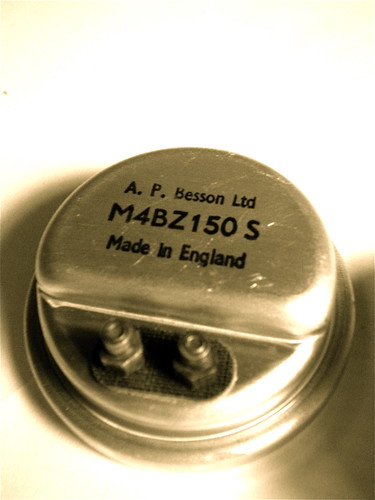


Sunday, December 12, 2010
This is just freaking cool; From Hack A Day
Link
[Enigma-penguin] built a tablet computer out of a Core2Duo Macbook circa 2007. The battery exploded, damaging the case and a few components inside. But there was hope for a new life as a tablet computer. He removed the screen and tested to make sure the computer would still function without it by using the video out port.
Putting the whole thing back together as a tablet proved to have some headaches. He worked through problems caused by the addition of a touchscreen between the LCD and the bezel and made the connections work with the screen flipped. The finished product looks so good because the bezel has not been turned around like on other tablet builds. Instead, a viewing window was cut in what would have been the case behind the screen.
There’s a little more to be done yet. The black USB cable seen above is the connector for the touchscreen which he plans to internalize. The magnetic sleep sensor has been relocated to the headphone jack. Inserting a plug (no cord necessary) puts it to sleep for transport. There’s also an on screen keyboard and the ability to change the screen orientation from landscape to portrait. After the break we’ve embedded one of [Enigma-penguin's] demonstrations.
Link
Labels:
DIY
Saturday, December 11, 2010
Point Contact PNP
This is from Tube Time Its a point contact PNP Transistor made form a diode.
"My friend Jeri Ellsworth recently figured out how to make a point contact transistor by cracking open a germanium diode. It looked pretty straightforward so (deviating from this blog’s usual content) I took a crack at it myself:"

"The original diode contact serves as the emitter connection. The base is the chip of germanium that is visible in the bottom part of the diode (with the stripe). The collector is a piece of phosphor bronze wire I pulled off the end of a guitar string. I sharpened it to a point with a Dremel sanding wheel and soldered it to a piece of bare wire to make it easier to handle.
The fine-pitched screws are used to maneuver the wires into contact with the block of germanium.
The germanium base is actually n-doped. To create the collector junction, you have to create p-doped regions. One crude way to do this is to apply a burst of current across the reverse-biased junction (positive voltage to base, negative voltage to collector). I don’t know if the mechanism is thermal or electrical, but phosphorus from the phosphor bronze wire gets carried into the germanium, creating the p-type region. For this experiment I used about 200V on a 10uF capacitor, and I discharged it into the junction through a 1K resistor. Jeri originally used something like 20V but I read in a paper several hundred volts were usually used for this purpose.
Jeri used an oscillator circuit to test her transistor, but I got lazy and just put it in a simple inverting amplifier circuit. At first the transistor didn’t work (output was in phase with the input) but after some tweaking of the wires, the output finally went 180 degrees out of phase. This is an absolutely terrible transistor, and the gain is really too low to consider this a transistor."
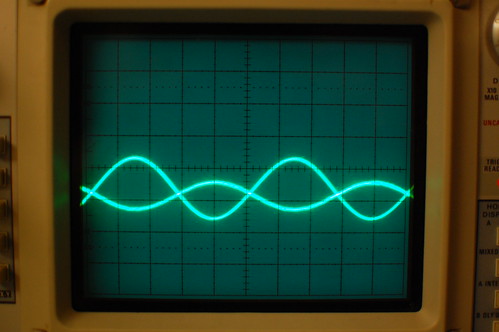
Check out the site for more cool stuff!
"My friend Jeri Ellsworth recently figured out how to make a point contact transistor by cracking open a germanium diode. It looked pretty straightforward so (deviating from this blog’s usual content) I took a crack at it myself:"

"The original diode contact serves as the emitter connection. The base is the chip of germanium that is visible in the bottom part of the diode (with the stripe). The collector is a piece of phosphor bronze wire I pulled off the end of a guitar string. I sharpened it to a point with a Dremel sanding wheel and soldered it to a piece of bare wire to make it easier to handle.
The fine-pitched screws are used to maneuver the wires into contact with the block of germanium.
The germanium base is actually n-doped. To create the collector junction, you have to create p-doped regions. One crude way to do this is to apply a burst of current across the reverse-biased junction (positive voltage to base, negative voltage to collector). I don’t know if the mechanism is thermal or electrical, but phosphorus from the phosphor bronze wire gets carried into the germanium, creating the p-type region. For this experiment I used about 200V on a 10uF capacitor, and I discharged it into the junction through a 1K resistor. Jeri originally used something like 20V but I read in a paper several hundred volts were usually used for this purpose.
Jeri used an oscillator circuit to test her transistor, but I got lazy and just put it in a simple inverting amplifier circuit. At first the transistor didn’t work (output was in phase with the input) but after some tweaking of the wires, the output finally went 180 degrees out of phase. This is an absolutely terrible transistor, and the gain is really too low to consider this a transistor."

Check out the site for more cool stuff!
Friday, December 10, 2010
16 Step Up/Down Sequencer
This is by Dr. Offset
"At some point in every DIY Synth enthusiast's journey they realize that they need some sort of structured way to control all the madness they've created. You want to build a sequencer. Often the first type of sequencer you build is something like the Baby 10, a ten step machine based off the 4017 decade counter chip. That's fine, and a lot of people do great music with it."
More info on this really cool sequencer can be found here
"At some point in every DIY Synth enthusiast's journey they realize that they need some sort of structured way to control all the madness they've created. You want to build a sequencer. Often the first type of sequencer you build is something like the Baby 10, a ten step machine based off the 4017 decade counter chip. That's fine, and a lot of people do great music with it."
More info on this really cool sequencer can be found here
Thursday, December 9, 2010
Fender Bender
Came across this on Ghost Effects. I this this is totally sweet. A 'weird sound generator' built into a Fender guitar by danwagoner! more pics here.
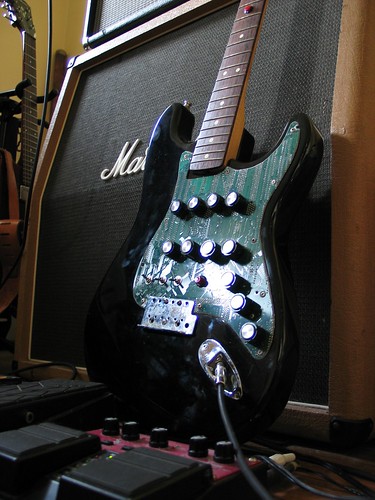
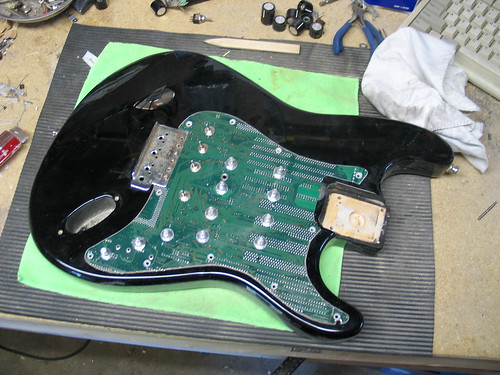




Wednesday, December 8, 2010
Scientists poke holes in NASA’s arsenic-eating microbe discovery
When NASA announced the discovery of an arsenic-eating microbe in a California lake last week, the agency hailed it as a suggestion that life as we know it, well, isn't life as we know it.
"We have cracked open the door to what is possible for life elsewhere in the universe," Felisa Wolfe-Simon of the NASA Astrobiology Instituteand U.S. Geological Survey, who led the study, said at a news conference.
NASA's team of astrobiologists had taken samples of the bacteria from mineral-dense Lake Mono -- in a volcanic region of Northern California near the Nevada border -- and starved them of phosphate, the meal of choice for most DNA-based organisms. Instead, the scientists force-fed the bacteria a form of arsenic, and, much to the researchers' surprise, the bacteria continued to grow and flourish on their new diet of poison.
Tuesday, December 7, 2010
Broke 2000
Thanks everyone for stoping by.
Labels:
General
Friday, December 3, 2010
Faces of Fuzz
Labels:
Clone,
Effects,
Fuzz Factory,
Personal Build
Thursday, December 2, 2010
Big Muff Triangle
This is a EHX Big Muff Triangle that I have been working on today; Its based on the layout by IvIark
Labels:
Big Muff,
DIY,
Effects,
EHX,
Personal Build
Wednesday, December 1, 2010
T.L.B.
Just another update of the Tube Loop Boost; Its all wired up and works properly but not perfectly, Ill need to do some tweaking to get it working 100%. Well enough chit chat here are some pictures.

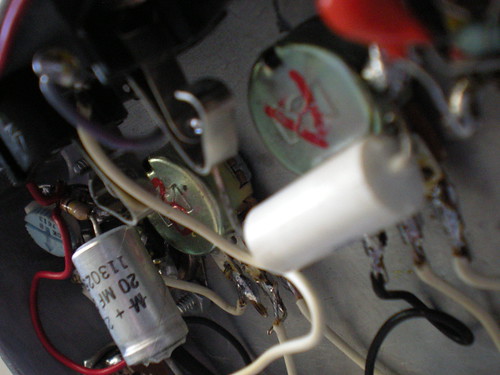
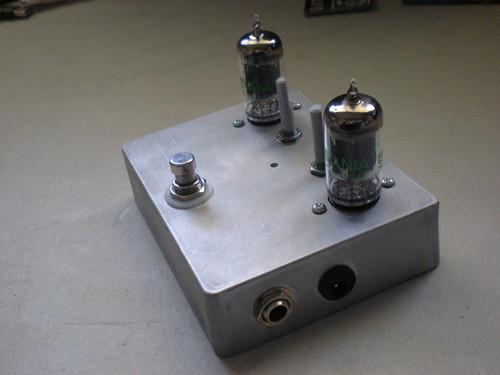



Labels:
DIY,
Effects,
Flicker,
Personal Build
Tuesday, November 30, 2010
Sunday, November 28, 2010
Tube Boost Looper
This is for a project that I am currently working on right now. Its a dual tube boost with a FX loop. Its based on the Bass Paralooper and the Valve Caster . I have two identical boosts, modified with larger input capacitors; Currently I am just using the trim pot to set the gain. More to come later!
Update:
So I drilled out the case yesterday but screwed up on the placement of the jacks for the loop send and return, they are in the way for the tube sockets. I think I'll take a brass strip and use that to cover up the existing hole and mount the jacks to that. Other than that screw up this is one of my most accurate drillings for an fx box.

Labels:
DIY,
Personal Build
Friday, November 26, 2010
Got a Few Old Unused Records Lying Around?
Matt Glassmeyer of Nashville, Tenn., built this roof out of 350 records. The roof is on the north side of the house and gets no direct sunlight, and shows no sign of warping.
[via MAKE via Core77 via Treehugger ]


[via MAKE via Core77 via Treehugger ]



Tuesday, November 23, 2010
Mammoth 2
This is yet another attempt at the Mammoth Fuzz I could not get the other to sound like I wanted it to so this one will work hopefully. Same layout as before from Tag Board Effects Used a Dermal tool to grind the Copper away leaving nice pads to solder onto. Build time was about an hour and half.

Please leave a comment telling me what you think.

Please leave a comment telling me what you think.
Labels:
Clone,
DIY,
Effects,
Mammoth,
Personal Build
Monday, November 22, 2010
Spoon Organ
This is from: C i b o M a h t o . c o m
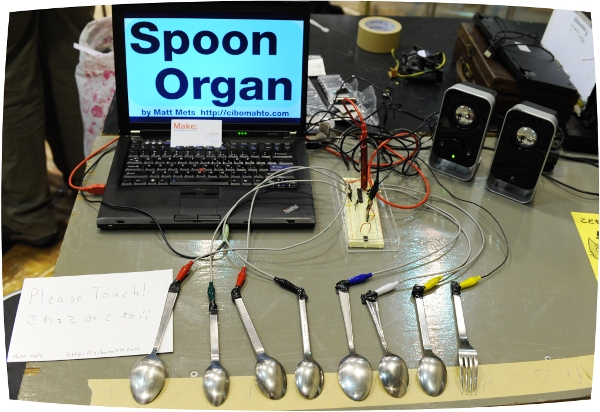
"Spoon Organ is an instrument that I created to show at the Make Tokyo Meeting 06 this past weekend. The user can play musical tunes simply by touching a row of spoons sitting on a table, with a fork added in for good measure. A microcontroller is used to detect changes in capacitance caused by a finger pressing against the metal, which are then sent to a computer using the MIDI protocol."

"Spoon Organ is an instrument that I created to show at the Make Tokyo Meeting 06 this past weekend. The user can play musical tunes simply by touching a row of spoons sitting on a table, with a fork added in for good measure. A microcontroller is used to detect changes in capacitance caused by a finger pressing against the metal, which are then sent to a computer using the MIDI protocol."
Friday, November 19, 2010
Mini Lunetta Patched Close up
Check out the Electro-music forums for more project info and users' builds.
This one is built bysndbyte's
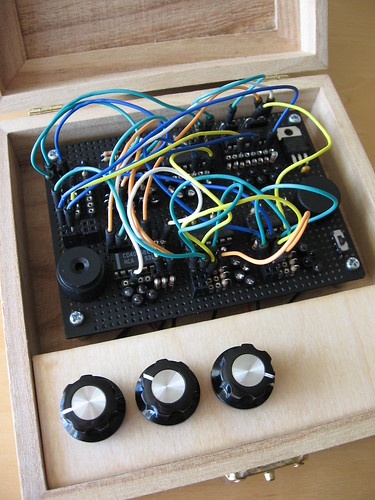

Wednesday, November 17, 2010
Electronic Music Studios
This excellent doco covering the origins and life of Electronic Music Studios. A company formed by avant-garde musicians & engineers who all shared a passion for electronic sound. Their collaborative efforts brought about the first digital electronic music sequencer, utilizing a relatively massive amount of computing power for the 1950s.
More info
More info
Monday, November 15, 2010
TorrentMeter - A Steampunk Bandwidth Meter
This is from Skytee
Its and analog gauge that displays the bandwidth of torrents being downloaded.
I got inspired by reading Tom Igoe's article in Make Magazine issue 11, about an antique gauge displaying air quality data from the web. It hit a nerve: friends and I had once built asteam powered teletype. Since we've got fiber optical intertubes at home, I wanted a big brass gauge telling me how big my pipe was. And that's the idea of my TorrentMeter.

Video of it in action.
Full Article
Its and analog gauge that displays the bandwidth of torrents being downloaded.
I got inspired by reading Tom Igoe's article in Make Magazine issue 11, about an antique gauge displaying air quality data from the web. It hit a nerve: friends and I had once built asteam powered teletype. Since we've got fiber optical intertubes at home, I wanted a big brass gauge telling me how big my pipe was. And that's the idea of my TorrentMeter.

Video of it in action.
Full Article
Sunday, November 14, 2010
010
This is a Fender 75 that my friend Rusty asked me to take a look at; the lead channel of it was not working on it. While working on it I took the opportunity to take some pictures of it, and since photo-shoped. Good news its working now but the bad news is that I don't know what I did in order to get it working again so if it fails again I am back at square one. 010 refers to the binary positions of the switches, great part is I did not plan that when I took the picture.
DIY RAM Memory- Register Style
This is from Instructables.com. Its an amazing hand built three bit memory. 

DIY RAM Memory- Register Style
**UPDATE** I also made a CMOS version here: http://www.instructables.com/id/DIY-CMOS-RAM-Memory/
If you have ever looked at a microcontroller's datasheet, you have probably seen something about registers. Registers are little one or two byte memory storage units in microcontrollers. The register in this instructable can hold 3 bits of data (b/c I ran out of room on my breadboards) using transistors. I did this to prove that I can, however, its not practical as an 8 bit register requires 64 transistors, about 64 resistors and lots of space.
The register is a neat device. It can recieve data when the enable input is, in my circuit, low and it can then latch and save the data even it the data line is changing. My circuit is not the conventional D-type latch because it used more transistors than I had.
If you have ever looked at a microcontroller's datasheet, you have probably seen something about registers. Registers are little one or two byte memory storage units in microcontrollers. The register in this instructable can hold 3 bits of data (b/c I ran out of room on my breadboards) using transistors. I did this to prove that I can, however, its not practical as an 8 bit register requires 64 transistors, about 64 resistors and lots of space.
The register is a neat device. It can recieve data when the enable input is, in my circuit, low and it can then latch and save the data even it the data line is changing. My circuit is not the conventional D-type latch because it used more transistors than I had.
Swishercutter left a great comment:
Labels:
DIY
Wednesday, November 10, 2010
Meet Meeblip
Via Make

Meet Meeblip, The Open Source, Hackable Digital Hardware Synth... Peter writes -
Making music, making blips and bleeps, turning knobs, plugging in keyboards, and having the freedom to modify your gear – these are good things. And that’s why I’m so excited that today is the day the MeeBlip launches.
It’s been several years in development, but now it’s finally here. It’s a hardware box that makes noises – virtual analog synth noises, chip-sounding noises, good noises, bad noises, noises you can make into music. It’s got physical knobs and switches on it, plus a MIDI DIN in port so you can connect that keytar you bought on eBay. It’s also a digital synth you can build, modify, and hack, down to the way every knob is mapped and every sound is blipped.
The MeeBlip is the creation of James Grahame, of Retro Thing and Reflex Audio fame. But we’re serious about the Create Digital Music name going on there, too. We’ll be documenting and helping develop this instrument for some time to come, and we’ve begun building a site and community for the instrument so you have a place to meet other people using it.
The MeeBlip, from code to schematics, is open source hardware. You can hack it, read through the code, make your own and sell it. At the same time, just because it’s “open source” and “hackable” doesn’t mean the MeeBlip is just for hackers. On the contrary – we wanted a synth anyone could play. With the Quick Build Kit, you can assemble the MeeBlip without a soldering iron or, really, much skill, in a matter of minutes. Plug it in, turn some knobs, and you can make some sounds. And if later you decide you want to go deeper or even change the way the instrument works, you can do that, too.
Check out their web site here

Meet Meeblip, The Open Source, Hackable Digital Hardware Synth... Peter writes -
Making music, making blips and bleeps, turning knobs, plugging in keyboards, and having the freedom to modify your gear – these are good things. And that’s why I’m so excited that today is the day the MeeBlip launches.
It’s been several years in development, but now it’s finally here. It’s a hardware box that makes noises – virtual analog synth noises, chip-sounding noises, good noises, bad noises, noises you can make into music. It’s got physical knobs and switches on it, plus a MIDI DIN in port so you can connect that keytar you bought on eBay. It’s also a digital synth you can build, modify, and hack, down to the way every knob is mapped and every sound is blipped.
The MeeBlip is the creation of James Grahame, of Retro Thing and Reflex Audio fame. But we’re serious about the Create Digital Music name going on there, too. We’ll be documenting and helping develop this instrument for some time to come, and we’ve begun building a site and community for the instrument so you have a place to meet other people using it.
The MeeBlip, from code to schematics, is open source hardware. You can hack it, read through the code, make your own and sell it. At the same time, just because it’s “open source” and “hackable” doesn’t mean the MeeBlip is just for hackers. On the contrary – we wanted a synth anyone could play. With the Quick Build Kit, you can assemble the MeeBlip without a soldering iron or, really, much skill, in a matter of minutes. Plug it in, turn some knobs, and you can make some sounds. And if later you decide you want to go deeper or even change the way the instrument works, you can do that, too.
Check out their web site here
Labels:
Make
1,003
Just broke 1000 page views thanks to every one that has been stoping by!
Labels:
General
Sunday, November 7, 2010
Benjolin Light Synth
This was made by Casper Electronics
"The sound in this video is all made using one my custom built synth that
you can read about it here.
The synth is made up of two complex analog oscillator/modulator/filter circuits,
a light control circuit and a modified BOSS RSD 10 sample/echo module.
I've started playing with a cool feature of the RSD 10 which is that it can
use external oscillators to control the playback rate of the echo and an
external clock to trigger the echo repeats. I'm using a sequenced oscillator
to melodically modulate the pitch of the echo of the other oscillators and
I'm using the sequence clock to trigger the echo. its a cool sounding
effect that gives a relatively normal sequence a bunch of cool quirks to
play with."
I want to make cool rhythmic like this, some day soon it will happen!
Apex Electronics
I got the chance to Apex Electronics today, I was stupid and forgot my camera at home. So, here is two images taken by Mighty Ohm. Going to build some cool tube boost with NOS tube sockets I got.
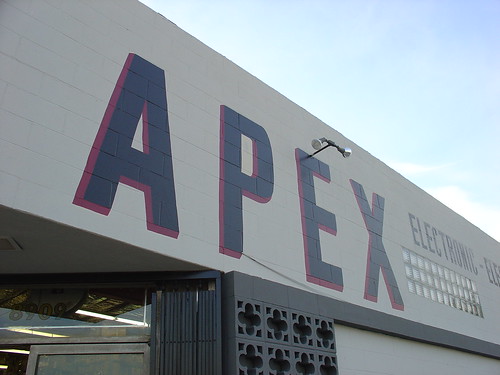
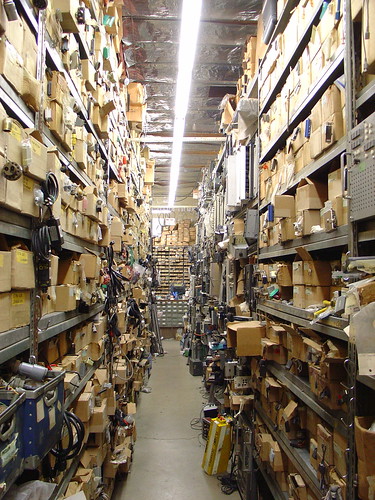
Flickr


Flickr
Subscribe to:
Posts (Atom)










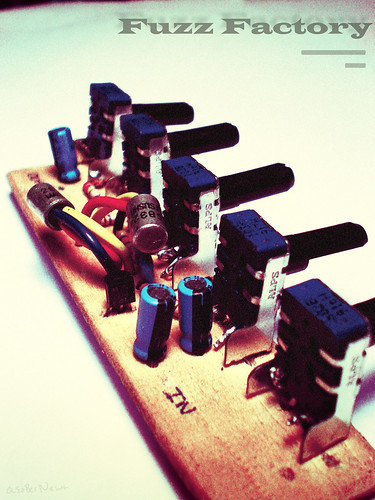
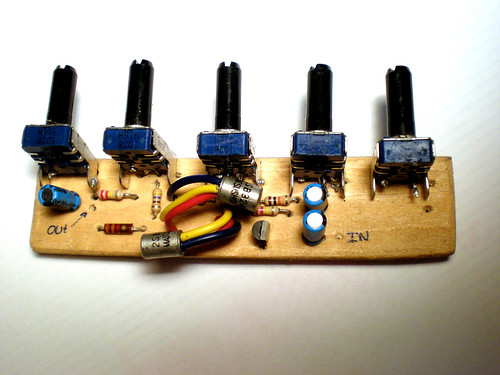
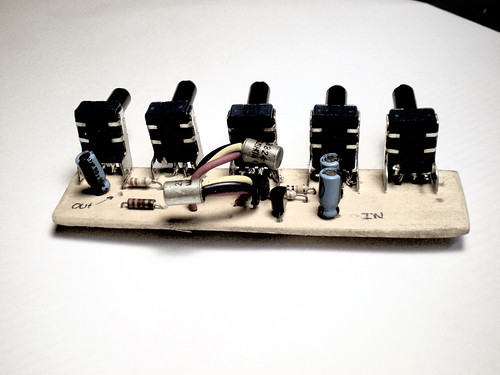









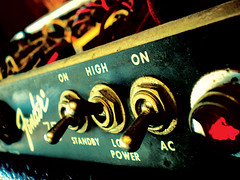
Whenever I see people build large scale versions of commonly available circuits I always think of my electronics instructor...he wanted to build a "Macroprocessor" which would be built from tubes and relays (he is an ex radar tech) as he put it "...it would be as big as a building, would put off a ton of heat as well as making the most wonderful clicking sound as it ran...".
Lets keep going on these types of Instructables...if we forget how these circuits are designed internally we become not only dependent on the circuit always being there but we also risk losing the spark of ingenuity which led to the design in the first place...you can only go further if you know how we got here.
Maybe we can start a "macroelectronics" tag just for things like this.